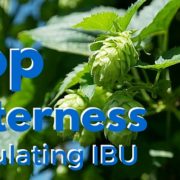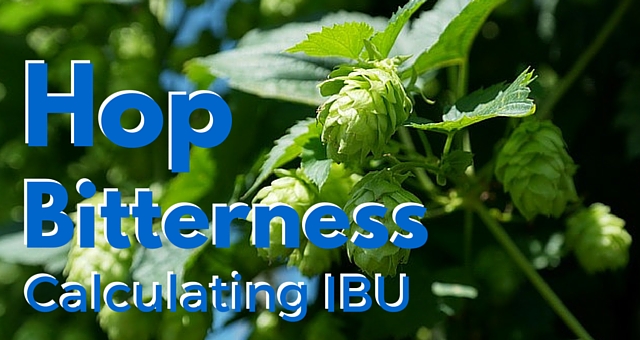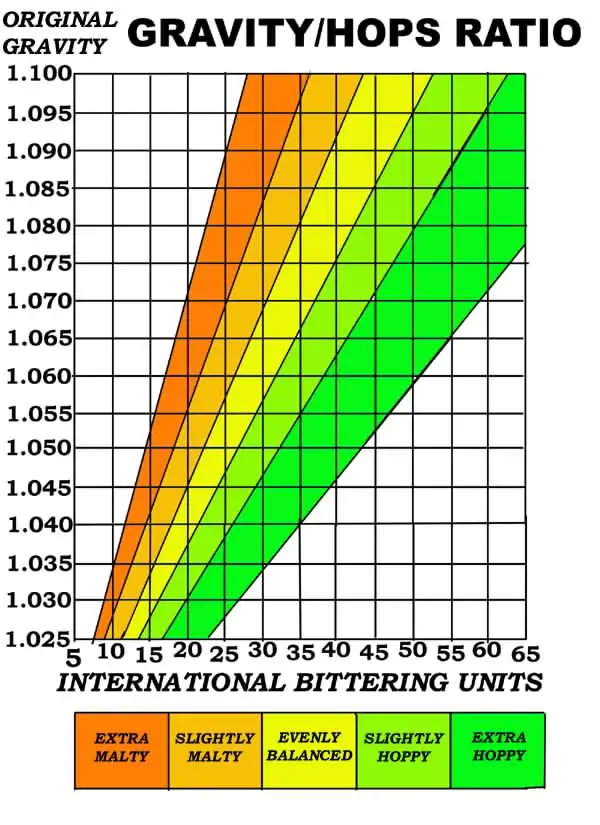Hop Bitterness and Calculating IBU
Hops are a complex ingredient in homebrew, there is a lot of involved biochemistry surrounding their interaction in the beer making process but it is good to know a little about what is happening when you use them because when you want to develop your own recipes, having some facts under your belt will lead to better beers.
The key things that we want to take from hops is to flavour and bitter the beer. Inside the hop cones are resins and oils that are produced in lupulin glands, these oils and resins are what we want to utilise. There are of course other aspects to hops but these two things; the oils which will give the beer flavour and aroma and the resins which will bitter our beer are what we are most concerned with.
There are a wide variety of hops available to brewers which usually come either whole and dried or in pellets. Certain style of beer such as English Ales or Belgian beers are strongly associated with certain varieties of hop because of the regions where those types of hops are grown. For example English Bitters are widely associated with East Kent Goldings.
Within these varieties Hops are separated into 2 types by the brewer, either bittering, aroma or dual use hops. Meaning some hop varieties will be used for bittering, some for flavour and aroma whilst a few will be used for both purposes.
The way they are used by both commercial and home brewers is by adding to the beer during the boil and this can happen at several stages throughout the boil which is most commonly 60 – 90 minutes. The reason multiple hop additions throughout the boil is, hops added at the beginning will lose much of the flavour or aroma and those added later will retain more aromatic qualities. In some instances hops are added to the fermenter after the boil in a process known as dry hopping which will impart a lot of hop aroma.
There are a lot of hop varieties to chose from and you will notice when you come to buy them that they are usually labelled with an alpha acid %. This alpha-acid among other things is what makes up the hop resins. The alpha acids are used to determine the hop bitterness and are expressed as the weight of alpha acid in relation to the weight of the hop flower itself. Most hops have an alpha-acid % in the range of 2 – 16%. So that means between 2 and 16% of the weight of the hop is the amount of bittering properties that are available.
The reason hops are boiled in the wort for an hour or more is because these alpha acids are not very soluble and by boiling for such periods of time allows a chemical process called isomerisation to occur.
Table of Contents
How Bitterness is Measured
Certain beer styles have differing amounts of bitterness. Knowing how much bitterness there is in a beer means when we formulate a recipe we can reproduce those characteristic in the beer we want to brew. This measurement of bitterness is called “International Bittering Units” (IBU).
When a recipe is formulated the Alpha Acid % that is associated with the hops can allow us to work out how much hops are needed in that beer, according to what level of IBU is needed.
IBU’s are a measurement that estimate how much of the alpha acids in the hops that are isomerised and dissolved into solution. These calculations are approximate to give the brewer a ballpark figure because hop utilisation is tricky to calculate precisely.
Hop Utilisation
The hop utilisation determines how well the alpha acids are isomerised during the boil. There are a few methods that can be used the Rager, Garetz and the Tinseth, you can see already there is no consensus on the subject.
Most software has all the methods built in. I tend to use the Tinseth method which takes into account the length of time the hops are boiled and the gravity of the wort. The following table shows this principle.
Decimal Alpha Acid Utilization vs. Boil Time and Wort Original Gravity Boil Original Gravity Time 1.030 1.040 1.050 1.060 1.070 1.080 1.090 1.100 1.110 1.120 1.130 (min) 0 0.000 0.000 0.000 0.000 0.000 0.000 0.000 0.000 0.000 0.000 0.000 3 0.034 0.031 0.029 0.026 0.024 0.022 0.020 0.018 0.017 0.015 0.014 6 0.065 0.059 0.054 0.049 0.045 0.041 0.038 0.035 0.032 0.029 0.026 9 0.092 0.084 0.077 0.070 0.064 0.059 0.054 0.049 0.045 0.041 0.037 12 0.116 0.106 0.097 0.088 0.081 0.074 0.068 0.062 0.056 0.052 0.047 15 0.137 0.125 0.114 0.105 0.096 0.087 0.080 0.073 0.067 0.061 0.056 18 0.156 0.142 0.130 0.119 0.109 0.099 0.091 0.083 0.076 0.069 0.063 21 0.173 0.158 0.144 0.132 0.120 0.110 0.101 0.092 0.084 0.077 0.070 24 0.187 0.171 0.157 0.143 0.131 0.120 0.109 0.100 0.091 0.083 0.076 27 0.201 0.183 0.168 0.153 0.140 0.128 0.117 0.107 0.098 0.089 0.082 30 0.212 0.194 0.177 0.162 0.148 0.135 0.124 0.113 0.103 0.094 0.086 33 0.223 0.203 0.186 0.170 0.155 0.142 0.130 0.119 0.108 0.099 0.091 36 0.232 0.212 0.194 0.177 0.162 0.148 0.135 0.124 0.113 0.103 0.094 39 0.240 0.219 0.200 0.183 0.167 0.153 0.140 0.128 0.117 0.107 0.098 42 0.247 0.226 0.206 0.189 0.172 0.158 0.144 0.132 0.120 0.110 0.101 45 0.253 0.232 0.212 0.194 0.177 0.162 0.148 0.135 0.123 0.113 0.103 48 0.259 0.237 0.216 0.198 0.181 0.165 0.151 0.138 0.126 0.115 0.105 51 0.264 0.241 0.221 0.202 0.184 0.169 0.154 0.141 0.129 0.118 0.108 54 0.269 0.246 0.224 0.205 0.188 0.171 0.157 0.143 0.131 0.120 0.109 57 0.273 0.249 0.228 0.208 0.190 0.174 0.159 0.145 0.133 0.121 0.111 60 0.276 0.252 0.231 0.211 0.193 0.176 0.161 0.147 0.135 0.123 0.112 70 0.285 0.261 0.238 0.218 0.199 0.182 0.166 0.152 0.139 0.127 0.116 80 0.291 0.266 0.243 0.222 0.203 0.186 0.170 0.155 0.142 0.130 0.119 90 0.295 0.270 0.247 0.226 0.206 0.188 0.172 0.157 0.144 0.132 0.120 120 0.301 0.275 0.252 0.230 0.210 0.192 0.176 0.161 0.147 0.134 0.123
The decimal that the table returns can then be used in a formula to calculate the IBU of the beer.
Calculating IBUs
When you want to work out how much bitterness will be in a beer you’ll first need to know a few details about the hops and the recipe you are brewing.
Several factors will alter the bitterness of a beer, things such as;
- The amount of hops used and their alpha acid content
- The volume of beer being made
- The length of time they are boiled
- The gravity of the wort / How strong the beer will be
You’ll see the last two points are covered in the Tinseth method of calculating hop utilisation. Armed with the above information we can input figures into the following formula to calculate bitterness:
$latex IBU = \frac{W\times A\% \times U \times 10}{V}&s=4$
W = Weight in grams
A% = Alpha Acid %
U = Utilisation
V = Volume in litres
If we are brewing a simple beer with one hop addition of 40 grams of East Kent Goldings at 60 minutes for example. We can work out how much bitterness they will add in a 18 litre batch of beer with a gravity of 1.042.
East Kent Goldings at 6% alpha acid
IBU = 40 x 6 x 0.252 x 10 / 18
IBU = 33.6
This can be a little complicated at first but I almost always use a calculator or software to do the workings for me. Learning the principles behind the process will mean you have a better understanding of the effect of hops in bittering the beer.
Storing Hops
One last thing that will affect the bitterness of your hops will be how fresh they are. Hops do not store well. You will notice they are usually vacuum packed as they will quickly oxidize and the amount of bitterness will drop drastically. If you can it is best to store hops in the fridge if you aren’t going to be used straight away. If you aren’t going to use them in the foreseeable future you can actually freeze them and they will last for much longer. Like anything though you want to use the freshest ingredients you can.
Balancing Hop Bitterness
I love simple rules or formulas that are easy to understand and help you make better beer. I also love graphs and charts that display them in an easy to understand manner. This post combines the two in perfect balance, which is what I want to talk about here.
Some beers are naturally malty in character (think scotch ales, bocks and brown ales) some are obviously hoppy or bitter (pale ales and IPA’s) Therefore we know the balance of some beers lean towards malt and others towards bitterness depending on the style. Maintaining the right relationship between the two for whatever style you are brewing means that this needs to be quantified, then you will be able to recreate this balance in your home brew.
In the book Designing Great Beers by Ray Daniels he outlines a simple formula to quickly find the balance of a beer using just two variables. The bitterness (IBU’s) and the original gravity (OG).
BU:GU
Take a look at the graph below and then we will take a look at the formula:
So let’s say you’re brewing a Weizenbock and you wanted to find the balance. The two bit’s of information we need are the IBU’s and the original gravity.
IBU = 26
OG = 1.073We then lose the 2 preceding digits on the OG to give us 73.
Then divide the IBU by the OG
IBU/OG = 26 / 73 = 0.35
So therefore the BU:GU = 0.35
You can plot this on the above graph and we can see the balance of this beer is on the border of extra malty and slightly malty.
Using this simple information we can look at any style of beer and find out what sort of balance we need to aim for in order to design a recipe for that style.






Leave a Reply
Want to join the discussion?Feel free to contribute!